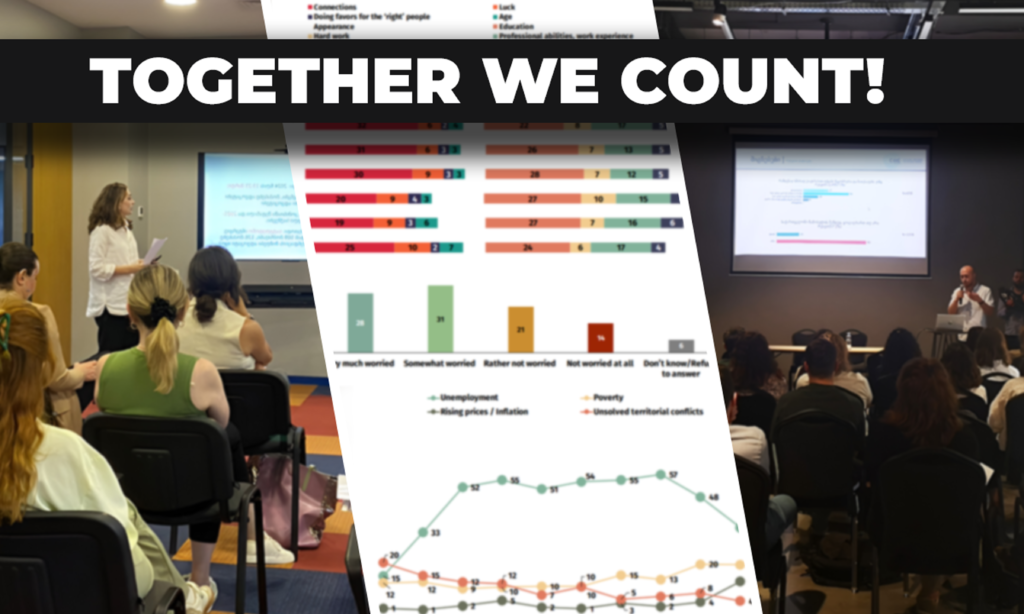The economy remains the main concern for people in Georgia. Together with the consumer price index and USD-GEL exchange rate rising, average household expenditures also have increased over the last couple of years. Meanwhile, according to recent data only 10% of the population has any savings. Although household expenditures have increased, what are people spending money on? The most recent CRRC-NDI survey from summer 2019 asked questions about household expenditures which provide a sense about what people spend money on in Georgia as well as who spends more on different categories of goods and services.
Most of the families in Georgia spend everything they earn. When asked about the largest monthly household expenses, everyday necessities came out on top, while leisure related expenditures were named by only a few. Food and utilities were named twice as frequently as any other expense. While this might not be a surprise, it is noteworthy that expenses on medicine came third, with more than one in three naming it as one of their largest monthly household expenses. Interestingly enough, some people, though a negligible number, still name travel, exercise, and entertainment related expenditures as the largest.
Note: Respondents were allowed to name up to three categories.
To understand how household expenditures vary between different demographic groups regression models were constructed. They included sex (male, female), age group (18-34, 35-54, 55 and +), settlement type (capital, large urban, small urban, rural), ethnic enclave status (primarily Georgian settlements, primarily minority settlements) and an additive index of ownership of different items, a common proxy for wealth.
When looking at the most common household expenses, food and utilities are on top regardless of people’s gender, age, the type of settlement they live in, or their economic situation. Nevertheless, the regression model showed that several demographic variables are useful in predicting who is more likely to have certain kinds of expenditures. For example, people who live in the capital are less likely to name loans/installments/mortgages as their largest monthly expenditure compared to people in small urban and rural areas. People over 55 and people with lower economic standing are much less likely to name this expenditure as well, compared to people who are younger and people with higher economic standing. Also, minority settlements are less likely to name loans compared to Georgian settlements.
Similarly, there are some small differences in terms of education costs as well. People who are over 55 and men are slightly less likely to name education related expenditures compared to younger people and women. In households with higher economic standing, education related expenses are more likely to be mentioned among the largest monthly household expenditures.
One of the most interesting issues to look at is spending on medicine. It is third highest on the list, which is telling: a third of the population is spending as much or more on medicine as food. There are also some interesting differences between various groups associated with medicine related expenses. People living in small urban and rural areas are more likely to name medicine among their top expenditures than those who live in the capital. Also, minority settlements are slightly less likely to mention medicine in their expenditures, than people from Georgian settlements. Similarly, younger people are one third as likely to name medicine, compared to people who are 56 or older. An additive index of ownership of household items shows that Georgians who own fewer things are more likely to say medicine is one of the top monthly expenditures in their household compared to people who own more. Differences between richer and poorer people hold even, when looking at people in different age groups. In all age groups people with higher economic standing name medicine less frequently than poorer people. Thus, older people and people with worse economic situations are more likely to name medicine as among their largest monthly expenditures. Interestingly, the same pattern is not present with medical care spending as opposed to spending on medication.
The data show that in all demographic groups in Georgia subsistence related expenses occupy the main position in household expenditures. Food, utilities, and medicine are the top expenditure categories for young and old, well-off and poor, men and women, and people in cities and rural areas. Though, there are of course some differences in expenditures between some demographic groups as well. Older people are less likely to have loans or education related expenses. Economically better off people are more likely to name these among their top expenditures. Moreover, older people and people with worse economic situations are more likely to name medicine related expenses, than younger people and those with better economic situation. Importantly, economic situation remains important even when controlling for age: better-off people are less likely to name medicine related expenses than the poor no matter their age.
Note: This blog post is based on logistic regression analyses. The dependent variable was a dummy variable for mentioning food, cost of utilities, medicine, medical care, or loans as the largest monthly household expense versus not naming this expense. The independent variables included sex, age group, settlement type, ethnic enclave status, and an additive index of ownership of household items. The data used in the above analysis is available here. The replication code can be found here.







